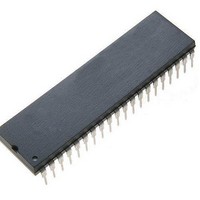PIC16F1517-E/P Microchip Technology, PIC16F1517-E/P Datasheet - Page 263

PIC16F1517-E/P
Manufacturer Part Number
PIC16F1517-E/P
Description
40-pin, 14KB Flash, 512B RAM, 10-bit ADC, 2xCCP, SPI, MI2C, EUSART, 2.3V-5.5V 40
Manufacturer
Microchip Technology
Series
PIC® XLP™ 16Fr
Datasheet
1.PIC16F1516-EMV.pdf
(344 pages)
Specifications of PIC16F1517-E/P
Processor Series
PIC16F151x
Core
PIC
Data Bus Width
8 bit
Program Memory Type
Flash
Program Memory Size
8 KB
Data Ram Size
512 B
Interface Type
I2C, SPI, USART
Maximum Clock Frequency
20 MHz
Number Of Programmable I/os
36
Number Of Timers
3
Operating Supply Voltage
2.3 V to 5.5 V
Maximum Operating Temperature
+ 125 C
Mounting Style
Through Hole
Package / Case
PDIP-40
Core Processor
PIC
Core Size
8-Bit
Speed
20MHz
Connectivity
I²C, LIN, SPI, UART/USART
Peripherals
Brown-out Detect/Reset, POR, PWM, WDT
Number Of I /o
36
Eeprom Size
-
Ram Size
512 x 8
Voltage - Supply (vcc/vdd)
2.3 V ~ 5.5 V
Data Converters
A/D 28x10b
Oscillator Type
Internal
Operating Temperature
-40°C ~ 125°C
Lead Free Status / Rohs Status
Details
Available stocks
Company
Part Number
Manufacturer
Quantity
Price
Company:
Part Number:
PIC16F1517-E/PT
Manufacturer:
Microchip Technology
Quantity:
10 000
- Current page: 263 of 344
- Download datasheet (3Mb)
22.5.2.3
The operation of the Synchronous Master and Slave
modes is identical (
Master Reception”
• Sleep
• CREN bit is always set, therefore the receiver is
• SREN bit, which is a “don’t care” in Slave mode
A character may be received while in Sleep mode by
setting the CREN bit prior to entering Sleep. Once the
word is received, the RSR register will transfer the data
to the RCREG register. If the RCIE enable bit is set, the
interrupt generated will wake the device from Sleep
and execute the next instruction. If the GIE bit is also
set, the program will branch to the interrupt vector.
TABLE 22-10: SUMMARY OF REGISTERS ASSOCIATED WITH SYNCHRONOUS SLAVE
2011 Microchip Technology Inc.
BAUDCON
INTCON
PIE1
PIR1
RCREG
RCSTA
TRISC
TXSTA
Legend: — = unimplemented location, read as ‘0’. Shaded cells are not used for Synchronous Slave Reception.
never Idle
Name
*
Page provides register information.
EUSART Synchronous Slave
Reception
TMR1GIE
TMR1GIF
ABDOVF
TRISC7
CSRC
SPEN
Bit 7
RECEPTION
GIE
), with the following exceptions:
Section 22.5.1.5 “Synchronous
TRISC6
RCIDL
ADIE
PEIE
ADIF
Bit 6
RX9
TX9
TMR0IE
TRISC5
SREN
TXEN
RCIE
RCIF
Bit 5
—
EUSART Receive Data Register
TRISC4
Preliminary
CREN
SCKP
SYNC
INTE
Bit 4
TXIE
TXIF
TRISC3
ADDEN
SENDB
BRG16
SSPIE
SSPIF
IOCIE
22.5.2.4
1.
2.
3.
4.
5.
6.
7.
8.
9.
Bit 3
PIC16(L)F1516/7/8/9
Set the SYNC and SPEN bits and clear the
CSRC bit.
Clear the ANSEL bit for both the CK and DT pins
(if applicable).
If interrupts are desired, set the RCIE bit of the
PIE1 register and the GIE and PEIE bits of the
INTCON register.
If 9-bit reception is desired, set the RX9 bit.
Set the CREN bit to enable reception.
The RCIF bit will be set when reception is
complete. An interrupt will be generated if the
RCIE bit was set.
If 9-bit mode is enabled, retrieve the Most
Significant bit from the RX9D bit of the RCSTA
register.
Retrieve the 8 Least Significant bits from the
receive FIFO by reading the RCREG register.
If an overrun error occurs, clear the error by
either clearing the CREN bit of the RCSTA
register or by clearing the SPEN bit which resets
the EUSART.
TMR0IF
CCP1IE
CCP1IF
TRISC2
BRGH
FERR
Bit 2
—
Synchronous Slave Reception
Set-up:
TMR2IE
TMR2IF
TRISC1
OERR
TRMT
WUE
Bit 1
INTF
TMR1IE
TMR1IF
TRISC0
ABDEN
IOCIF
RX9D
TX9D
Bit 0
DS41452B-page 263
Register
on Page
242*
248
247
123
246
80
81
83
Related parts for PIC16F1517-E/P
Image
Part Number
Description
Manufacturer
Datasheet
Request
R

Part Number:
Description:
IC, 8BIT MCU, PIC16F, 32MHZ, SOIC-18
Manufacturer:
Microchip Technology
Datasheet:

Part Number:
Description:
IC, 8BIT MCU, PIC16F, 32MHZ, SSOP-20
Manufacturer:
Microchip Technology
Datasheet:

Part Number:
Description:
IC, 8BIT MCU, PIC16F, 32MHZ, DIP-18
Manufacturer:
Microchip Technology
Datasheet:

Part Number:
Description:
IC, 8BIT MCU, PIC16F, 32MHZ, QFN-28
Manufacturer:
Microchip Technology
Datasheet:

Part Number:
Description:
IC, 8BIT MCU, PIC16F, 32MHZ, QFN-28
Manufacturer:
Microchip Technology
Datasheet:

Part Number:
Description:
IC, 8BIT MCU, PIC16F, 32MHZ, QFN-28
Manufacturer:
Microchip Technology
Datasheet:

Part Number:
Description:
IC, 8BIT MCU, PIC16F, 32MHZ, SSOP-20
Manufacturer:
Microchip Technology
Datasheet:

Part Number:
Description:
IC, 8BIT MCU, PIC16F, 20MHZ, DIP-40
Manufacturer:
Microchip Technology
Datasheet:

Part Number:
Description:
IC, 8BIT MCU, PIC16F, 32MHZ, QFN-28
Manufacturer:
Microchip Technology
Datasheet:

Part Number:
Description:
IC, 8BIT MCU, PIC16F, 20MHZ, MQFP-44
Manufacturer:
Microchip Technology
Datasheet:

Part Number:
Description:
IC, 8BIT MCU, PIC16F, 20MHZ, QFN-20
Manufacturer:
Microchip Technology
Datasheet:

Part Number:
Description:
IC, 8BIT MCU, PIC16F, 32MHZ, QFN-28
Manufacturer:
Microchip Technology
Datasheet:

Part Number:
Description:
MCU 14KB FLASH 768B RAM 64-TQFP
Manufacturer:
Microchip Technology
Datasheet:

Part Number:
Description:
7 KB Flash, 384 Bytes RAM, 32 MHz Int. Osc, 16 I/0, Enhanced Mid Range Core, Low
Manufacturer:
Microchip Technology

Part Number:
Description:
14KB Flash, 512B RAM, 256B EEPROM, LCD, 1.8-5.5V 40 UQFN 5x5x0.5mm TUBE
Manufacturer:
Microchip Technology
Datasheet:











